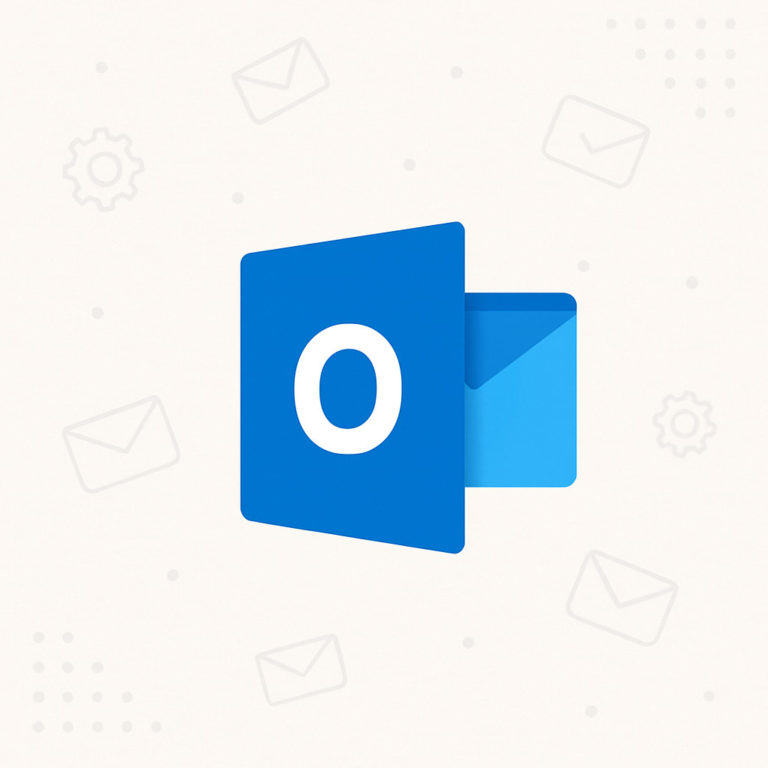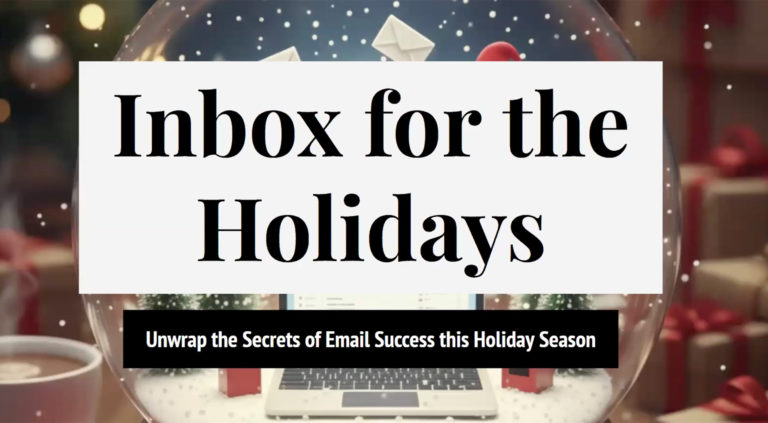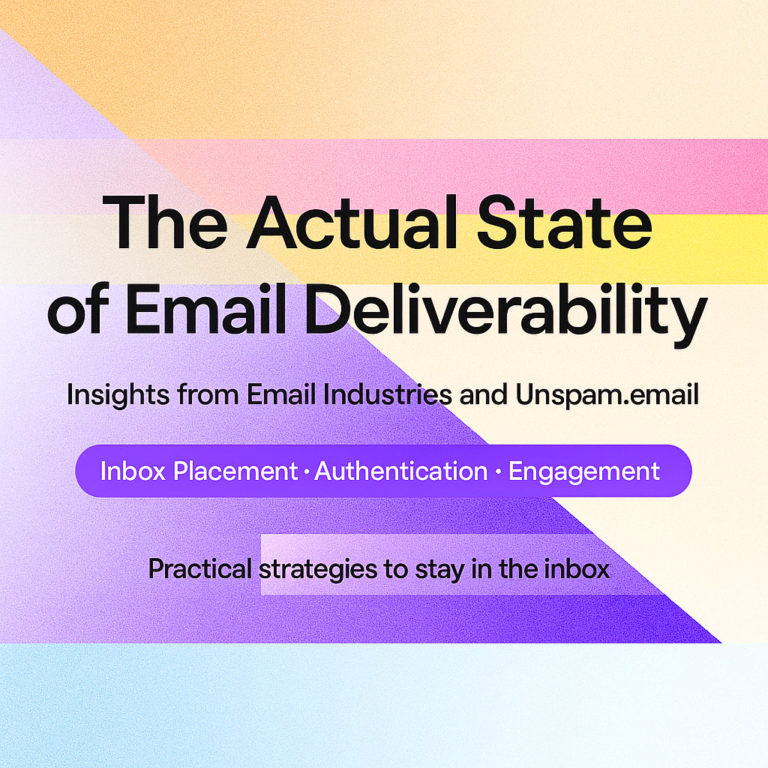You created a stunning email copy. The design was attractive and everything was in perfect motion. You hit “send”.
You waited hours (even days), but heard just crickets!
No opens. No clicks. No response. You start wondering, “if your email even landed in their inbox”.
This is the story of many. Every day, over 376.5 billion emails are sent and received. But sadly, not every email sent reaches its destination.
Email deliverability is often ignored but it’s essential if you want to keep sending emails without breaking a sweat. It’s the ability of emails to reach the right inbox, not the spam folder. No bouncing back and definitely not vanishing into thin air.
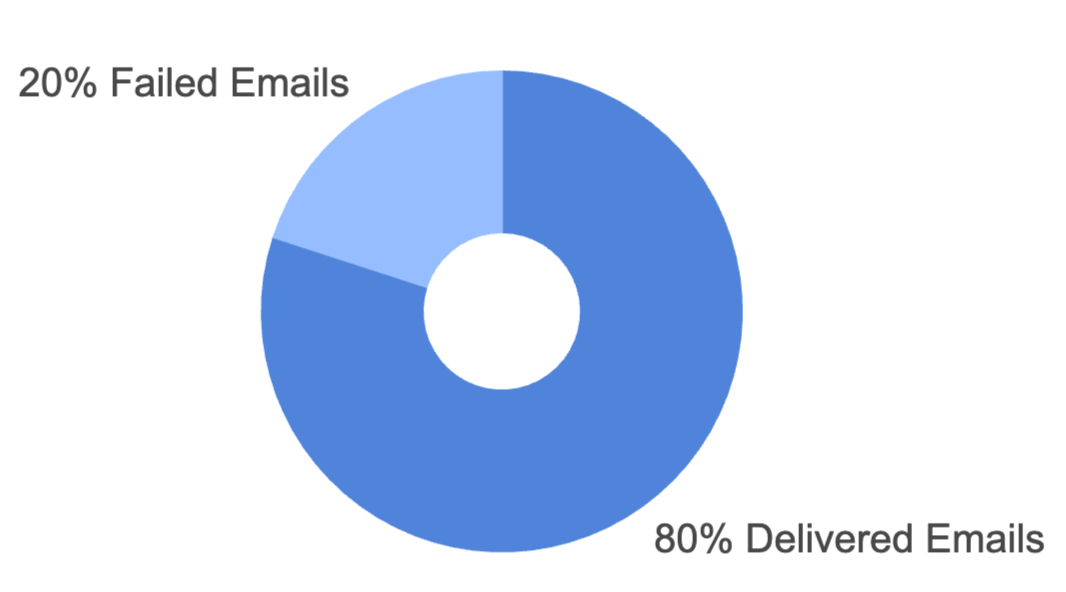
It doesn’t matter how great your message is if it’s not delivered. Reports say 20% of emails (1 out of every 5) fail to reach the target inbox. In a B2B scenario, one missed email means broken communication, missed opportunities, lost engagement, and a dent in your brand’s credibility.
So, if you’re battling high bounce rates and spam folder nightmares, this email deliverability guide breaks down common reasons for email delivery failures and how to fix them.
Why is Your Email not Being Delivered? 8 Reasons & Solutions
If you are wondering, “Why are my emails not going through?” Let’s understand the reasons and ways to fix them.
1. You’re Sending to Invalid/Wrong Email Addresses
You can’t send your message to an email address that never existed.
Suppose you’re throwing a backyard barbecue party. The playlist is fire, burgers sizzling, and drinks chilling. But only half your invites showed up. The other half went to abandoned houses and to a friend who moved to Alaska without leaving a forwarding address
Some of the addresses don’t exist and some are wrong.
That’s what happens when your email list has invalid, wrong, or misspelled email addresses. It could happen due to human error. Sometimes, recipients enter incorrect email addresses when filling contact forms (eg, “gmail.con” instead of “gmail.com”).
Every time your email hits a bad address, it’s a hard bounce. If you keep sending emails to those addresses, the bounce rate spikes. This is a red flag for email service providers. They may start blocking your emails or send them straight to the spam folder because of this.
Invalid addresses tank your sender reputation faster than a nosy neighbor calling the cops on your party.
How to fix:
Revisit your email list regularly to weed out misspelled or invalid addresses. You can also use an email verification tool to verify if your email list has invalid addresses and remove them.
If some users have not opened your emails in months, they are unengaged or probably inactive, or uninterested subscribers. Sending them emails won’t add any value to your business but only raise ISPs’ suspicion. Get rid of them.
Keep updating the list with new, valid emails. Having a clean, engaged email list is worth your efforts and time. You can also go a step further to reconnect previous subscribers via social channels. Check them if they are still interested.
Pro tip: Use a safe opt-in method. Don’t send emails to the purchased emails. It will ensure you have accurate and valid addresses and keep the spam score from increasing.
2. Your Emails Failed Authentication
Missing or misconfigured authentication records could be the reason you’re facing issues with delivery. Emails from an authenticated domain are like verified passports for inbox providers to trust you.
Looking at increasing email-based cyberattacks, such as phishing, mailbox providers want senders to authenticate their emails with SPF, DMARC, and DKIM standards. It offers better security and user experience and improves inbox deliverability.
Although spam filters eliminate unwanted emails, they may sometimes flag a legitimate email to be spam. Email authentication protocols help here by confirming the sender’s identity and protecting their domain from phishing and spoofing attacks.
- Sender Policy Framework (SPF): It’s like a guest list at the front gate. SPF tells mail providers the servers that are allowed to send emails. Others won’t get in.
- DomainKeys Identified Mail (DKIM): It works like a tamper-proof wax seal on your email. DKIM confirms that your message really came from you and the content has not been altered in transit.
- Domain-based Message Authentication, Reporting, and Conformance (DMARC): Working like a digital security guard, DMARC does what SPF and DKIM do and also adds a policy. It states what mailbox providers should do if the email fails the authentication checks: none (no action), reject, or quarantine it.
How to fix:
If you run email marketing campaigns where trust is everything, you must authenticate your domain. Start by setting up email authentication records for your sender domain.
- Set up SPF: Add a DNS record to permit your email service provider to send emails from your domain. Make sure the SPF record has all your legitimate email sources. Also, you can use a free SPF record checker to verify the status.
- Set up DKIM: Generate a key pair and publish it to your DNS. Seek online guidance for the process.
- Add a DMARC record: It instructs mail providers on how to handle messages that fail to authenticate. Start with a “none” policy to receive authentication outcomes and then move slowly to a “reject” policy.
3. Your Domain Name or IP Is Blocklisted
Let’s say you walk into a hotel lobby. Dressed well, you’re ready for a big meeting.
“Sorry, we can’t let you in. You’re flagged.” The front desk tells you this.
If email service providers have blocklisted your domain or IP address, that’s what is likely to happen to your emails. It will result in email delivery failure. They won’t even land in the spam folder, straight out blocked at the gate. Blocklists work like a digital security watchlist.
The reason your domain or IP may end up on the blocklist could be:
- Sending emails to too many invalid addresses
- Too many recipients reported you as spam
- A sender with a shared IP who misbehaved
- Malware in your emails (even by accident)
Even if you didn’t do anything wrong, you might have to pay the price.
How to fix:
Blacklist recovery is possible but takes time. You will need to make some changes and wait patiently to earn trust.
- Use a free blacklist checker tool to find if your domain or IP is listed.
- If yes, find out the reason. Check request logs or bounce messages.
- Get in touch with the email service provider and request removal. Share what went wrong, how, and what you’ve fixed. Be polite while you do this.
- Clean your email list. Remove unengaged, wrong, and invalid emails.
- Slow down the number of emails you send. Do it mindfully while your reputation heals.
4. Your Content Triggers Spam Filters
Have you ever been pulled aside because the airport security found something suspicious in your bag?
Even if nothing dangerous comes out of it, you’ll be stopped for enquiry if they suspect something.
Scary, but essential for safety.
Spam filters work like security checkpoints. They stop emails from going to the inbox if the content looks suspicious. Examples:
- Not enough text, but many documents or images are attached
- Mismatched URLs
- Words, such as “ACT NOW”, “FREE!!!”, “CLICK HERE”, etc.
- Every word in a subject line is capitalized
- No personalization
If your email content has these elements, it may not reach the destination. Also, some recipients set up policies for incoming/outgoing emails. They may block messages with suspicious attachments or URLs or block certain senders.
How to fix:
48% of participants find it difficult to stay out of spam. But it’s doable.
Your emails should read like a thoughtful message, not a pushy ad. Make it helpful and relevant. Here are some of the ways to bypass spam filters and improve deliverability:
- Personalize the email with the recipient’s name and talk about some common ground.
- Write like you’re talking to a person, not to a bot.
- Don’t use link shorteners. They add to the suspicion.
- Keep the structure clean. Balance text and images and avoid capital letters until necessary. Give a clear CTA.
For bulk emails, it’s best to test the email before sending and check what spam filters flag. Correct it and resend.
5. Your Sender Domain/IP Reputation Is Bad
Your domain’s online reputation is important. You can send emails from a shared IP, but the domain belongs to one sender only. Your email sending activities directly influence your domain’s reputation and email deliverability.
But what triggers a bad domain reputation?
- Too many user complaints
- Many emails are recognized as spam
- Sending emails to unengaged emails or invalid users
- Using a shared IP that others have abused
Internet service providers (ISPs) calculate domain/IP reputation based on the above activities. They check past emails for bounce rates, spam, etc. Similarly, in a sharing IP pool, everyone’s credibility drops if one person spreads spam.
How to fix:
Here’s what you can do to improve your email reputation:
- Use a dedicated IP if you send bulk emails. That way, you won’t be penalized for someone else’s fault.
- Build your trust via emails like networking, not spamming.
- Use tools to monitor your domain’s health.
- Try separating domains based on purpose. Example: Use your main domain to send transactional emails and a subdomain for marketing emails, such as cold emails.
- Keep testing your email deliverability and resolving issues.
6. Your Subscribers Aren’t Engaged Enough
Suppose you’re at a networking event. You keep talking to someone and sharing your ideas, but they’re showing no interest.
Similarly, if the recipients don’t open or engage with the emails you sent, mailbox providers assume your content is not serving users. When users continue ignoring your emails, mailbox providers may reroute them to the spam folder or “promotions” tab.
Sorry, but that’s the reality!
The reason is that people’s priorities change. They are busy. If your emails don’t provide them immediate value, they stop engaging with them.
How to fix?
It’s not that those recipients hate you. It’s that they forgot the very reason they signed up with you. It’s time to remind them, but gently.
- Be highly relevant. Surface-level personalization doesn’t work anymore. Address their pain points and goals based on who they are (CFO, marketing lead, end-user, etc.). Give them a solution.
- Send less but say more. 1 high-value email weekly beats 5 generic ones, every time.
- Grab their attention within 3 seconds with compelling subject lines. It must not be scary or fishy, though.
- Ask for interaction in your email by asking a question. Something like “Which of these points resonated with you the most?” might work.
- Check engagement metrics. Experience with different styles to figure out what works best for your audience.
The whole point is to earn the recipient’s trust. It encourages them to engage with you.
7. Your Email Size Exceeded the Limit
Can you squeeze a king-sized mattress into a compact elevator? I guess not.
That’s your oversized emails trying to fit into a recipient’s inbox.
Most email service providers set an email size limit of around 10-15 MB. Going overboard will only get your emails rejected. Attaching high-resolution images, large videos, bulky PDFs, etc., to your email makes it bulky.
How to fix?
- Know the size cap of your email service.
- Identify the emails and attachments with the size exceeding the limit.
- Compress heavier attachments using online tools.
- Reduce image resolutions to what’s acceptable.
- Host bulky files to Google Drive or a company server and then share a link with the recipient.
Pro tip: Always check email size before sending the email. In general, emails under 100 KB offer faster deliverability and respects inbox capacity of the recipient.
8. Recipient Inbox Is Full
Sometimes, it’s not your fault if emails are not going through. If the recipient’s inbox is full, it can’t receive new emails. Your email bounces back with the message “mailbox full”.
Although modern email providers give ample storage, this issue can happen if the recipient has abandoned their inbox. Alternatively, they may not be aware of it, probably due to being busy.
How to fix?
- Connect to the recipient through other channels, such as phone or social media. Alert them that their inbox is full. If they wish to continue using the inbox, they will clear up the space.
- Remove people from your email list who have not interacted with you for the last 1 year.
- Monitor bounces. Separate full-mailbox bounces from bounces due to invalid domains.
Checklist to Improve Email Deliverability
Here are some email deliverability checklists you can consider following:
- Verify email addresses: Before hitting send, make an effort to know if they actually exist. You can use email verification tools to verify the addresses and steer clear of hard bounces.
- Authenticate with SPF, DKIM, and DMARC: Get your domain authenticated with these protocols so the email service provider can trust you and deliver you emails to the right inboxes.
- Scan for blocklists: Find out if your domain/IP is on a blocklist and request for removal.
- Personalize your email content: Address people by their names, establish common grounds, talk about their problems, and provide a solution. Build relationships.
- Avoid spammy language: Don’t scream for attention, earn it. Ditch all-caps words, too many exclamation marks, and oversalesy phrases. Write like you’re talking to them 1:1.
- Be consistent: Avoid inbox ambushes. Instead, pick a schedule and stick to it for sending emails. They will look forward to it, if you provide value every time.
- Offer unsubscribe option: Always give a way out in case they no longer want your emails. This builds trust and keeps mutual respect.
- Test before sending: Test your emails before sending. Check the formatting, look, and file size. Also, use tools to test where it lands. If you hit spam, fix errors and retry.
- Segment: Segment your audience based on their location, interest, behavior, etc. and send relevant emails to them. Also, segment your marketing and transactional emails and use different domains for them.
- Seek help: If you’re facing trouble figuring things out by yourself and need professional help, you can look for a reliable email deliverability consultancy.
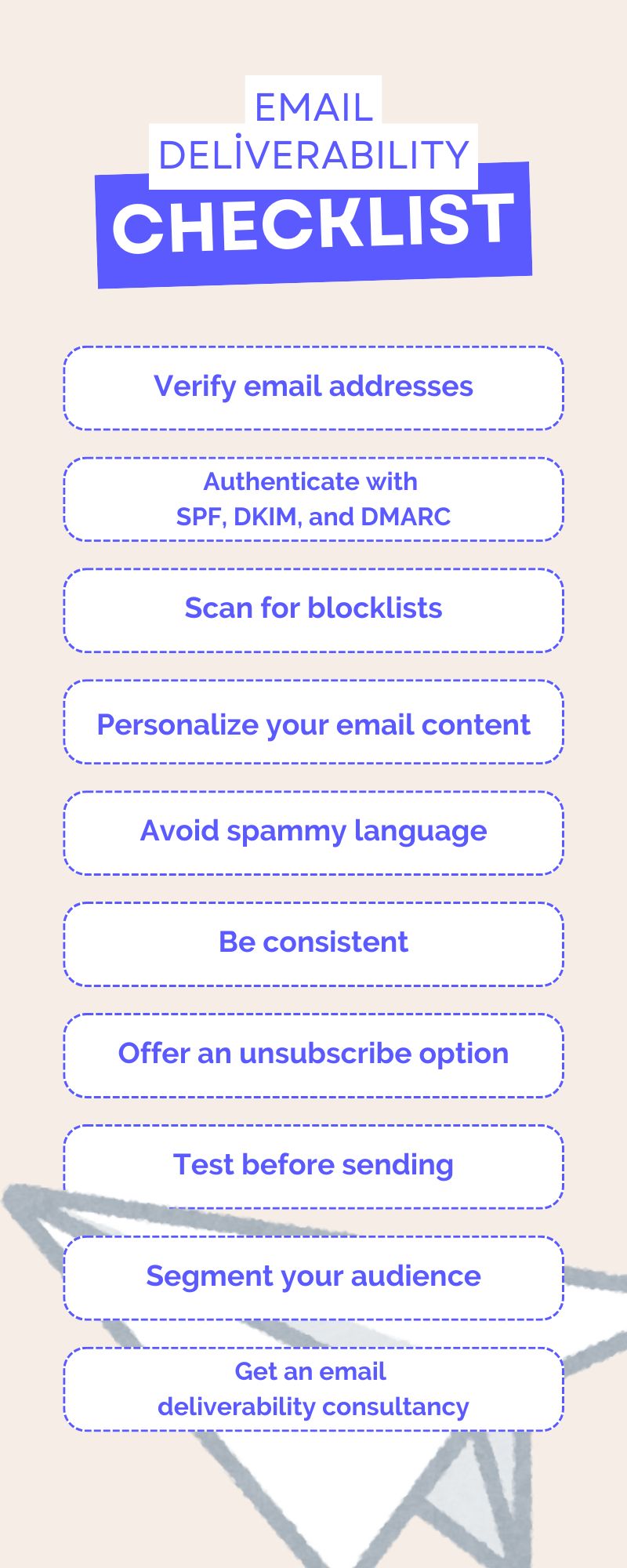
You can use this checklist infographic by copying the code below:
<a href='https://unspam.email/articles/why-is-my-email-not-being-delivered/' 'https://unspam.email/articles/wp-content/uploads/2025/06/email-deliverability-checklist.jpg'> Email Deliverability Checklist Infographich by unspam.email</a>Conclusion: How to Make Sure Your Emails Get Seen
If your emails don’t reach their destination, chances are these culprits are to blame:
- The email list is filled with invalid addresses
- Poor sender reputation weight you down
- Emails size exceeding the limit
- Recipient’s mailbox storage is full
- Your domain is not authenticated with SPF, DKIM, or DMARC
- The message content failed to engage people or looks spammy
Like a high-performance car, your email needs regular audits, monitoring, and maintenance.
Treat your emails as a tool to start a conversation and build trust, not to annoy people with sales pitches. Keep cleaning your email list to send emails to correct and engaged users. Authenticate your domain and request removal from blocklists. Follow email deliverability best practices to increase the chances of emails landing in the right inbox.
FAQs
What are the common reasons why emails are not delivered?
Invalid email address, poor domain reputation, spammy content, no authentication, etc., are common reasons for an email not getting delivered.
How can I improve my email deliverability rate?
Clean your list, authenticate your domain, improve sender reputation, and personalize content to improve delivery rate.
What are spam filters, and how do they affect email delivery?
Spam filters are automated systems that analyze incoming emails and flag and block suspicious emails.
Are there any best practices for ensuring emails reach the inbox?
Yes, authenticate your domain, avoid spammy words, segment your email list, and send relevant content.
What should I do if my email bounces back?
If your email bounced back, find out if it’s a soft or hard bounce. Soft bounces are temporary but hard bounces need you to clean your mist, check for typos, and request removal from blocklists.


